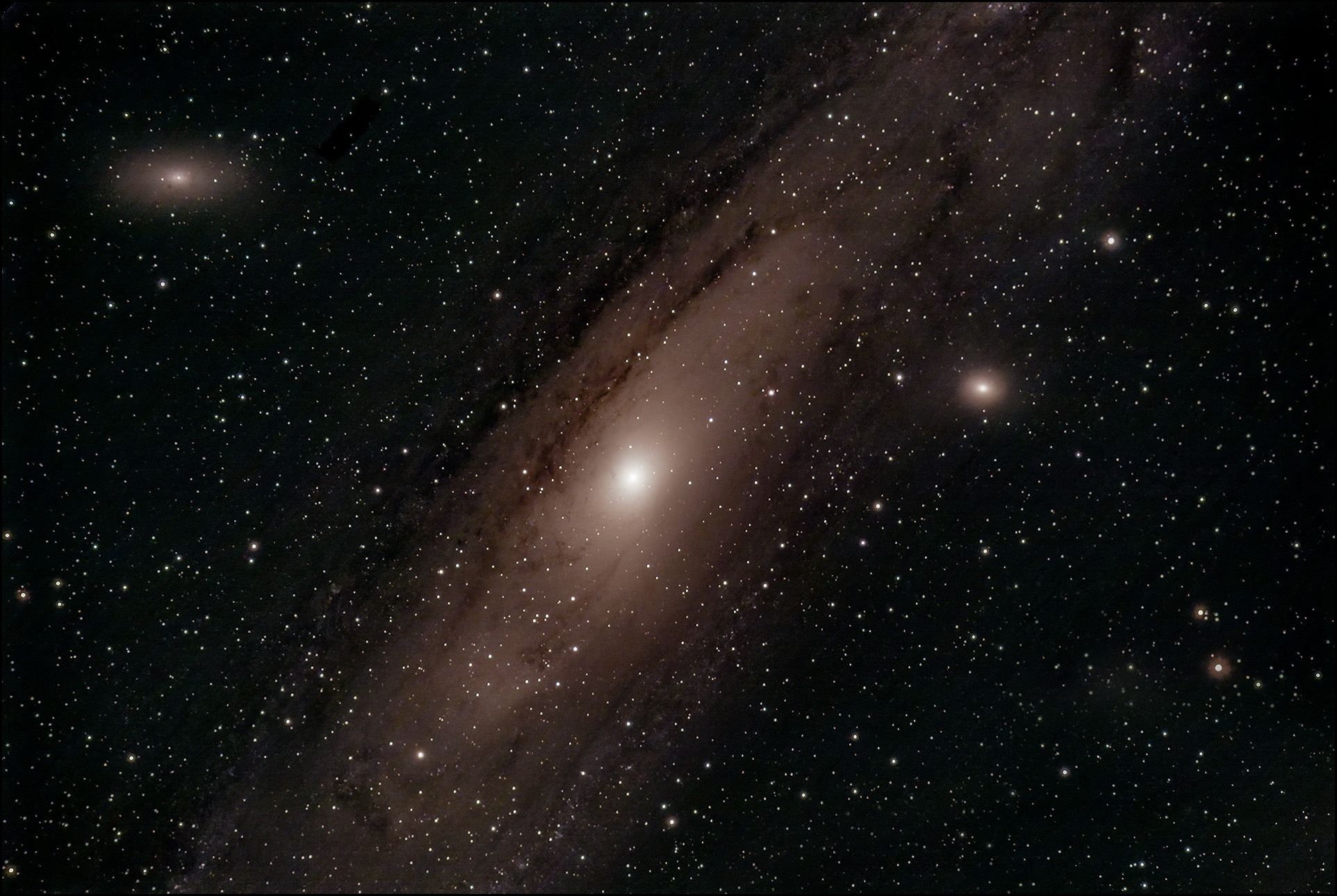I headed out to a local semi-darkish spot in Trabuco Canyon last night, mostly to test my autoguiding software. Sadly, it continued not to work. I'm not sure what I'm doing wrong.
The sky in Trabuco Canyon is not great (it's still Orange County, which is swamped by the Los Angeles light dome) but it's better than my backyard. So I went ahead and took a couple of pictures as long as I was there. One of them didn't work at all and probably needs a darker sky and longer exposure times. The other is the Andromeda Galaxy. This was a quickie image, and not all that great. Still, progress is being made!
The small object at the top left is a dwarf elliptical galaxy (M110) that orbits Andromeda. The bright object at center right is a compact elliptical galaxy (M32) that's yet another satellite of Andromeda.


Wow, Kevin, this is amazing!
Very cool!
Keep ‘em coming Kevin! Very cool
Very Impressive! You always seem to get the most out of your equipment....which perplexes me a little...some people seem to have an almost intuitive sense on how things work...or, they have faith in their ability to suss things out...and so they do, while for most people, They do not.
So is it your faith in yourself or an inaint aptitude? Maybe sort of Nature v. Nuture again...Best Wishes, Traveller
"This was a quickie image, and not all that great. Still, progress is being made!"
I should say! Wow.
Nice! Now I'm wondering if the Milky Way has its own satellite galaxies. I guess I have to go down a search rabbit hole.
Yes, it does!
Wikipedia: The Milky Way is currently accreting material from several small galaxies, including two of its largest satellite galaxies, the Large and Small Magellanic Clouds, through the Magellanic Stream.
You can easily see the Magellanic Clouds from the Southern Hemisphere. I've seen them from South Africa on a couple of occasions.
Rent a cabin at the V6 Ranch.
On two occasions I saw the first comets after a lifetime of looking.
Dark sky to the max.
Noice!
Good job! Keep at it.
Beautiful work, Kevin Drum! Just don't forget to employ your simpler equipment for Friday Cat Blogging.
Hey Kevin, you mentioned autoguiding problems and I am pretty sure it is due to your mount not sufficiently aligned to the celestial north pole. You mentioned using a compass to get it pointing North. *THIS ISN"T GOING TO BE GOOD ENOUGH* You are imaging at 900mm f/l, that is challenging for even the most experienced astrophotographer. If you don't have a decent polar alignment with your scope/mount, the star drift in the field of view can be more than your autoguiding setup can correct.
My suggestion is to 1) USE THE BUILT IN POLAR SCOPE! the EQ6-R says it has a built in polar scope. That may not be enough, and I would also do a separate drift alignment using PHD2 (It has that functionality) with your guide camera. Getting a decent polar alignment is key for long exposure AP. The closer to polar alignment you are the less work your autoguider has to do to keep things centered and the sharper your images will be. It will also allow you to push the length of your exposures longer.
You have OPT Telescope down in Oceanside available and I am pretty sure that they would be glad to help you out with any questions/problems you have getting up and running with AP (heck you may have bought your stuff from them as far as I know).
Also, your ASI120MM is a halfway decent planetary imager if you decided to point it at some of the planets. You would need color filters to do color images, but you could get some decent mono images w/o filters.
I use NINA's built in polar alignment, which works great. My polar alignment was accurate to within a few arcseconds.
+1 to zAmboni for general Sunday good helpfulness!
Kevin, you may think "not all that great," but I'm a reader who is also an amateur stargazer, and not much interested in astrophotography. I do like the pretty pictures sometimes, but my interest is hunting down objects by hand--no computers, just (paper) charts--and then the aesthetics of seeing it with my own eyes. So I love this image of the Andromeda Galaxy. It's like an amped-up image of what I see with my eyes, instead of the sometimes cartoony images so popular with modern processing.
The one thing I knoew about Andromeda is that it is the only object in the sky visible to the naked eye that is *outside* our own galaxy.
That's pretty ... wow.
The Magellanic Clouds have been known since ancient times to indigenous peoples across South America and Africa, says Wikipedia. They are themselves galaxies orbiting ours.
What fun Kevin! We get to visualize outer space and enjoy your progress. Keep up the good work and keep posting
One day we will see it close up.
I think I see somebody waving.
Contratulations. I'm sure your images will continue to improve. I read Sky & Telescope, so I know how much fun it can be to put together a scope and explore the skies.
I'm way too lazy. If I got serious, I'd probably buy a Stellina or evScope and let someone else package everything including the software. Sometimes the technology gets good enough. I drove a manual transmission car for decades, but this time I bought an automatic.
So, Cokedup Werewolf Aileen Cannon just all but reinstated El Jefe Maximo de Maralago to the presidency, & Elizabeth Warren Democrat Kevin Drum is fixed on his telescope & the Andromeda Galaxy?
Actually, that seems onbrand.